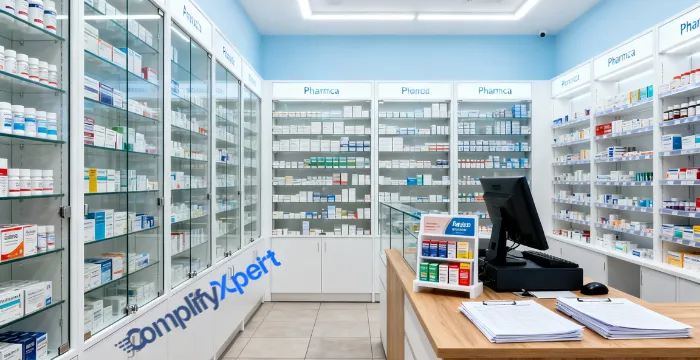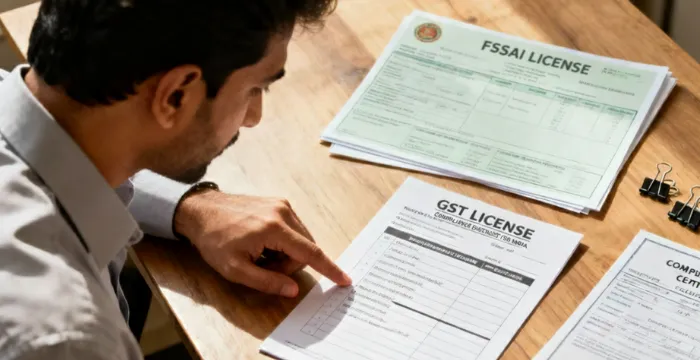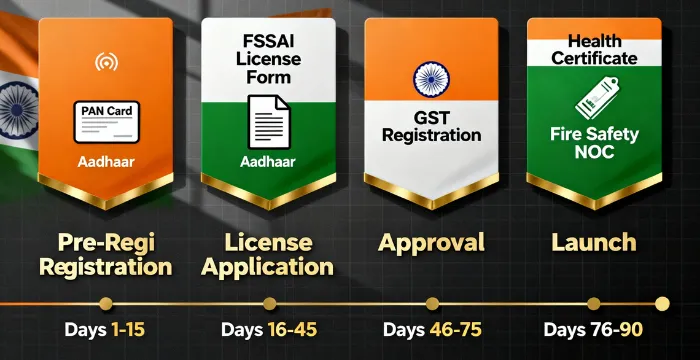Class A NSNM Medical Device Registration | Non-Sterile & Non-Measuring Devices
Navigating the regulatory landscape of medical devices in India can be very challenging, especially if one is considering compliance with emerging standards. The NSNM medical device industry is highly intricate regarding classification, documentation, and registration. ComplifyXpert has simplified this process with tailored compliance solutions so businesses can concentrate on innovation and growth.
- Complicated technical file preparation (device master file, plant master file).
- Difficulty identifying applicable standards and risk classification.
- Frequent queries from the CDSCO during the review stage.
- Coordination issues between manufacturer and authorized agent.
- Time-consuming approval and license renewal processes.
Get your personalized compliance roadmap
No fees. No obligations.
Introduction to Non-Sterile and Non-Measuring (NSNM) Devices
One of India's most significant medical devices is the NSNM Medical Device, which falls under Class A and thus poses minimal risks to patients and users.
While a sterilized product has no exposure to any form of sterilization and does not make measurements, these NSNM products are straightforward to produce and register.
Here are a few examples of Non-Sterile and Non-Measuring (NSNM) medical devices:
- Bandages and adhesive dressings
- Surgical gloves
- Thermometers (non-digital)
- Cotton rolls and gauze
Even though classified as low-risk, Class A Non-Sterile and Non-Measuring (NSNM) medical devices must comply with regulatory safety and efficacy requirements. All **Class A devices under which NSNM falls** shall be registered with CDSCO before manufacturing, importation, or sale in India. In this regard, Medical Devices Rules 2017 calls for such registration from CDSCO.
Here at ComplifyXpert, we understand the specific requirements for NSNM device registration. We help businesses identify the correct classification, gather technical documentation, and efficiently complete registration. Our solutions are designed to minimize your team's effort while ensuring full compliance with CDSCO regulations.
Those regulatory requirements are decoded, the management of documents is eliminated, and tight timelines are forgotten with ComplifyXpert. Under our lead, registering NSNM devices for our company shall be streamlined and hassle-free.
Class A Medical Devices in India
Class A devices are the lowest-risk category of medical devices under the Medical Devices Rules, 2017. Class A medical devices are generally used and have less contact with the human body. They also do not pose high risks to the patient or user.
Definition and Examples of Class A Non-Sterile and Non-Measuring Medical Devices
Class A Non-Sterile and Non-Measuring (NSNM) medical devices are those that fulfill all these qualifications:
- Non-invasive: The device does not enter the skin or body cavity.
- Low-risk: The risk level during its application is very minimal.
- Non-sterile and/or non-measuring: Most Class A devices fall in the NSNM category
Examples of Class A NSNM Medical Devices
- Non-Sterile Adhesive Bandages (Class A NSNM device)
- Surgical gloves (Non-Sterile medical device)
- Cotton Rolls and Absorbent Dressings (NSNM classification)
- Basic Thermometers (Non-Measuring Class A device)
- Tongue Depressors (Non-Sterile, Non-Measuring)
Significance of Class A Medical Devices
Although these devices fall under the low-risk category, their safety and effectiveness are of the utmost importance because they are used directly by healthcare professionals and patients. Proper compliance establishes that these devices will be of a quality standard and not cause any potential harm.
India's Regulatory Requirements for Class A Medical Devices
The Medical Devices Rules, 2017, became effective on January 1, 2018, and established a fully integrated regulatory framework for medical devices in India. Class A medical devices are lawfully manufactured, imported, distributed, or sold in or through India.
Major Regulatory Requirements
Registration is Compulsory:
CDSCO requires the registration of manufacturers and importers for Class A devices. The process requires detailed information concerning the product, manufacturing process, and intended use.
Quality Management System (QMS):
ISO 13485 certification is compulsory for Class A devices, as it proves international quality management standards for medical devices.
Device Master File:
It is a detailed document elaborating on the design, specifications, materials, and intended device use.
Free Sale Certificate:
Imported devices should have a free sale certificate from their country of origin to ascertain that they are accepted for use in other markets.
Post-Market Surveillance:
Class A devices are registered and thereafter subject to periodic inspections and audits for compliance with continued safety and quality standards.
Regulation for Medical Devices in India
India's medical device industry operates within a well-defined regulatory framework established by the Medical Devices Rules, 2017, effective January 1, 2018. The rules ensure that all medical devices comply with stringent quality, safety, and efficacy standards while promoting growth in the medical device sector.
Principal Regulatory Bodies and Their Functions:
Central Drugs Standard Control Organization (CDSCO):
- The primary regulating body oversees medical device approval, licensing, and post-market surveillance.
- Enforcement and Compliance, Medical Devices Rules, 2017
State Licensing Authorities, SLA
- Monitoring Manufacturing Facilities, Adherence to Good Manufacturing Practices (GMP), Class A and B devices
Ministry of Health and Family Welfare
- The ministry supervises CDSCO in devising the National Policy for Medical Devices.
Medical Devices Rules, 2017: An Overview
This set of regulations divides medical devices into four classes (A, B, C, D) based on risk levels:
- Class A: Low-risk devices (e.g., bandages, surgical gloves).
- Class B: Low-to-moderate risk devices (e.g., hypodermic needles).
- Class C: Moderate-to-high-risk devices (e.g., orthopedic implants).
- Class D: High-risk devices (e.g., cardiac stents).
Key Highlights of the Rules:
- Classification: Devices are categorized based on risk to ensure appropriate regulatory oversight.
- Licensing: Manufacturers and importers require licensing for individual device classes.
- Quality Assurance: All devices should conform to the quality assurance requirement ISO 13485.
- Post-Market Surveillance: Devices are kept under surveillance post-clearance to ensure and rectify the potential risk posed by any product.
- Penalty for Non-Conformity: Strict punishment, jail term, and fine imposed.
Registration and Licensing Procedure
The registration process for Class A and B devices involves State Licensing Authorities, whereas CDSCO handles Class C and D devices with higher risk. Imported devices are approved and registered only by CDSCO.
Benefits of Class A NSNM (Non-Sterile and Non-Measuring) Medical Device Registration
Registration of Class A NSNM (Non-Sterile and Non-Measuring) medical devices with CDSCO has various benefits:
Mandatory Registration
NSNM Medical Device Registration is compulsory with CDSCO for India's market entry. Without proper Class A medical device registration, the manufacturer and importer cannot sell the devices.
Regulatory Compliance
The device will ensure quality and safety standards for protecting patients and end-users. A registered product helps build consumer confidence and establishes the manufacturer/importer as a market leader.
Operational Efficiency
Registration helps the smooth functioning of the supply chain process in India and import-export and distribution activities.
Step-by-Step Guide to NSNM Medical Device Registration in India
Registration of non-sterile and non-measuring medical devices falling under Class A is essential for manufacturers and importers in India. Though the regulations are less complicated than those of the higher-risk classes, a systematic and detailed process must be followed to ensure that the CDSCO regulations are followed.
Step 1: Determine if Your Product Qualifies as a Class A Non-Sterile and Non-Measuring (NSNM) Medical Device
The first and most critical step is identifying whether your product qualifies as a non-sterile and non-measuring Class A medical device. This involves:
- Evaluating the Class A NSNM device's intended use and risk level.
- Ensuring the Non-Sterile, Non-Measuring device does not have sterile or measuring components.
- Reviewing CDSCO's device classification list for confirmation that your product qualifies as a Class A Non-Sterile and Non-Measuring medical device.
ComplifyXpert offers expert guidance to classify your device to avoid application errors correctly if you're unsure.
Step 2: Register Your NSNM Medical Device Manufacturing Facility with State Licensing Authority
For Indian manufacturers, the manufacturing facility must be registered with the State Licensing Authority of the local state. The significant steps include:
Manufacturing License
- The facility must comply with GMP under the Medical Devices Rules, 2017.
- For importers, the foreign manufacturing site needs to have the necessary certifications, such as ISO 13485, and be approved by the regulatory authorities in the country of origin.
Step 3: Prepare Required NSNM Medical Device Registration Documentation for CDSCO
Accurate and comprehensive documentation is the key for Class A NSNM medical device registration to be successful. The following is a list of mandatory documents needed for Class A Non-Sterile and Non-Measuring device registration:
Device Master File (DMF)
A comprehensive document including;
- Description of the device (including materials, design, and intended use).
- Risk analysis and safety precautions.
- Labelling and packaging information.
ISO 13485 Certification
Demonstration of a quality management system that complies with the requirements of international standards for medical devices
Free Sale Certificate (FSC)
Imported devices: It shows the product is certified for sale in its country of origin.
Product Testing Reports:
Reports of testing from authorized laboratories, assuring the device's safety and performance.
License to Manufacture or Importer Permit:
As a matter of manufacture locally or as an importer
Affidavit of Compliance
It is a signed declaration that confirms their compliance with the CDSCO standards. At ComplifyXpert, we help prepare reviews and submit them to CDSCO for compliance.
Step 4: Submission of the Application on CDSCO Online Portal
The CDSCO has a portal through which an online system is provided for registration of medical devices. Applicants should:
- Log onto the Sugam portal that CDSCO offers.
- Fill out the application form; this form is with details about the device, the manufacturing site, and the applicant.
- Upload all supporting documents in a prescribed format.
- Pay the relevant registration fee online.
Step 5: Verification by CDSCO for Review
Once the application is submitted, the CDSCO will scrutinize all the documents presented to ensure compliance with regulatory standards. The steps involved at this stage include:
Technical Document Scrutiny: Verifying whether the documents presented are accurate and authentic.
Site Inspection (if necessary): The State Licensing Authority may inspect the facility of domestic manufacturers to confirm compliance with GMP standards.
Step 6: Issuance of Registration Certificate
Upon successful review, the CDSCO releases a Class A NSNM medical device registration certificate. Such a certificate empowers the legal manufacture, import, or sale of the product in India.
Other Registration-Related Requirements
Time for Application Processing
Ordinarily, the process takes 2 to 3 months, although more time is added if there is incomplete documentation and technical questions have been raised by CDSCO.
Registration Fees
The registration fee for Class A NSNM devices is relatively low, making it economical for small and medium-sized manufacturers. The applicant is required to pay fees through the online Sugam portal while submitting applications.
Registration Renewal
A medical device registration certificate has a limited period (generally five years), after which the applicant must renew it.
General Issues Encountered during NSNM Device Registration
Poor Documentation
One of the main reasons for delays is because of documentation errors. ComplifyXpert always makes sure that your documents are correct according to regulatory standards.
Lack of Technical Knowledge
First-time applicants can easily find themselves in confusion while understanding some intricate details in the CDSCO rules and regulations.
Use of Online Portal
CDSCO's online portal, although convenient, can cause a lot of confusion among its users if not accustomed to its user interface.
Challenges in Class A Medical Device Registration
Though it is the most straightforward category, there can be problems associated with it. Some of them include:
1. Almost intricate documentation requirements
Challenging preparatory work of technical files along with supporting documents.
2. Changes in CDSCO guidelines and rules
Possible delays in approval
3. Small mistakes
Addition or omissions during the application process may delay the approval date, which affects the business timeline.
Role of CDSCO in Class A NSNM Medical Device Regulation
The apex governing body responsible for regulating medical devices in India is the Central Drugs Standard Control Organisation (CDSCO). Since the organization is the regulatory body at the national level, all medical devices must meet the required safety, efficacy, and quality standards.
Important Functions of CDSCO
Classification and Approval of NSNM Medical Devices:
- CDSCO classifies Non-Sterile and Non-Measuring (NSNM) devices into Class A, B, C, and D based on risk levels.
- Approves and registers Class A medical devices for manufacturing, import, and sale in India.
Licensing and Registration:
- Issues licenses to manufacturers and importers for Class A NSNM medical devices in all risk categories.
- Facilities are ensured to align with Good Manufacturing Practices (GMP) for Class A Non-Sterile Medical Devices.
Quality Assurance:
- ISO 13485 is the international quality standard which needs to be followed.
- Manages labelling, packaging, and safety features of devices.
Post-Market Surveillance:
- After getting approval, the devices are checked for safety concerns.
- Immediate action is taken when there is a product recall or adverse event.
Compliance Enforcement:
- Regular inspection and audit for continued compliance
- Penalties for non-compliance with regulatory standards
CDSCO's Online Systems
CDSCO recently introduced the sugam portal for online registration of medical devices;
- It streamlines processes and assists with application submission and tracking.
- Payment of registration fees.
- Documentation uploads.
Why CDSCO’s Role Is Critical
The CDSCO protects public health by ensuring that only safe and effective devices are available in the Indian market. Its stringent regulations and oversight mechanisms foster trust among consumers and healthcare providers.
Sterile vs. Non-Sterile Medical Devices
Sterile and non-sterile are the primary categorizations used to classify the cleanliness level of medical devices or their intended application. Understanding a manufacturer, provider, and regulating authority is required.
Sterile Medical Devices:
Sterile devices are made to eliminate all kinds of microbial life, meaning there are no bacteria, viruses, fungi, or spores. They are highly needed in any surgery and any medical applications requiring avoiding infections.
Examples
- Surgical instrumentation
- Catheters
- Implantation devices such as pacemakers
Regulatory Needs for Sterile Devices
- They must be sterilized according to most strict standards, such as EO sterilization or gamma irradiation.
- Must carry special marking to identify sterility.
- Involve more stringent regulatory oversight owing to meaningful use.
What are Non-Sterile Medical Devices?
Non-sterile devices are exempt from sterilization before being utilized. They are normally risk-free and can be used in cases where there is no absolute need for a sterile device.
Examples:
- Adhesive bandages
- Surgical gloves
- Non-invasive thermometers
Benefits of Non-Sterile Devices
Key Differences Between Sterile and Non-Sterile Devices
| Aspect | Sterile Devices | Non-Sterile Devices |
| Microbial Presence | Completely free of microbes | May have a minimal microbial presence (within safe limits) |
| Applications | Critical surgical/medical use | General healthcare use |
| Regulation | Strict sterilization standards | Lower regulatory oversight |
| Cost | Higher manufacturing costs | Lower costs |
Role of ComplifyXpert: Whether sterile or non-sterile, ComplifyXpert offers full support in ensuring that devices meet all regulatory requirements, such as classification, documentation, and compliance standards.
How ComplifyXpert Simplifies Class A NSNM Medical Device Registration
At ComplifyXpert, we make the Class A NSNM (Non-Sterile and Non-Measuring) Medical Device Registration process simple and compliant with CDSCO regulations. Our experts handle every aspect to ensure quick approval and full documentation support.
- All Documentation Support: Master files of devices, reports of risk analysis, and ISO certifications.
- Complete Support: From all levels of classification to final registration.
- Instant Update: Stay updated with every regulatory update.
FAQ
How does CDSCO classify medical devices?
Medical devices are classified under Class A, B, C, and D based on risk levels as classified under the Medical Devices Rules, 2017.
Is the registration available online?
CDSCO has an online system for medical devices, which makes the application process much more manageable.
What are the charges for Class A device registration?
The registration charges are very low, so the manufacturer can afford to pay.
What are the penalties imposed for non-compliance?
Penalties for non-compliance include fines and suspension of operations.
What is the difference between sterile and non-sterile devices?
Sterilized devices are those which are sterilized. Non-sterilized devices are those that are not sterilized.
What is a Class A NSNM Medical Device and why does it need CDSCO registration?
Class A medical devices are low-risk products, such as bandages and surgical gloves, where basic regulatory controls apply.
What documents are needed to register a Class A Non-Sterile and Non-Measuring Medical Device with CDSCO?
ISO 13485 certification, risk analysis, and technical specifications. The registration period for Class A is six months.
Do importers of Class A NSNM medical devices need CDSCO registration?
Yes, importers have to seek registration of Class A devices into CDSCO.
Why ComplifyXpert for NSNM Device Registration?
- Experienced guidance: Our experts know the inside-out of CDSCO regulations.
- Smooth processes: We take care of everything, from preparation of paperwork to final approval.
- Economical solutions: Value-for-money through time and money saving.
ComplifyXpert is committed to making compliance simple, efficient, and hassle-free. We will help you navigate the complexities of your regulatory requirements as you focus on growing your business.
Visit ComplifyXpert today for more information on how we can help register non-sterile and non-measuring (NSNM) devices.


